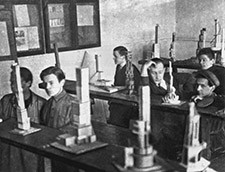In his canonical 1936 chart mapping the development of modern art, Alfred H. Barr, Jr., the founding director of MoMA, prominently placed Constructivism and Suprematism right beneath Cubism. The two Russian avant-garde movements were considered its two more prominent outcomes, along with De Stijl and Neoplasticism – all of which drew on what he called, the “machine esthetic.” The Staatliche Bauhaus is placed just below—in turn, a product of these, also powered by the esthetic of the machine. Notwithstanding the prominent role assigned to the avant-garde, Barr chose to omit a contemporary of the Bauhaus—a school that, arguably, played a central role in articulating both the theoretical programs and the practical outcomes of its movements.
Conceived by the Bolshevik government as a “specialized educational institution for advanced artistic and technical training,” the Higher Art and Technical Studios, collectively known as Vkhutemas (Вхутемас), were created to “prepare highly qualified artist-practitioners for the modern industry.” From its establishment, this interdisciplinary school offered free education and accepted students from underprivileged backgrounds. While similar, according to Barr, to the Bauhaus in its “communistic spirit,” Vkhutemas, with an enrollment of over 2000 students, was an unprecedented modern undertaking, an institution that “focused on developing the masses.” The mandate for mass education was framed within the larger project of the industrialization of the Soviet economy and the grounding of everything—from artistic to labor practices—in science. Vkhutemas faculty emphasized the link between design practice and the so-called “objective method.” Continuous feedback between educational process and tests performed at various “research laboratories” at Vkhutemas facilitated an enormous leap in the development of both the theory and practice of modern space and form.

